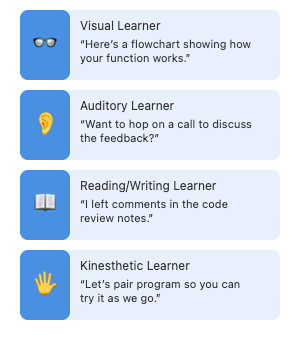Welcome to Adapting Feedback for Impact.
Giving feedback isn’t just about pointing out what’s right or wrong. It’s about helping your mentee learn, grow, and feel supported. The way you deliver feedback can make the difference between a mentee who feels empowered to improve and one who feels discouraged. When you adapt your feedback to your mentee’s learning style, timing, and needs, you build trust and set the stage for real progress.
In this course, you’ll learn how to:
- Adapt your feedback style to match your mentee’s preferences and learning needs, so they feel confident asking for and receiving feedback
- Turn mistakes into teaching moments, helping your mentee learn and grow from them
- Celebrate wins of all sizes to help your mentee build confidence in their abilities
- Welcome feedback as a mentor to model openness and show appreciation for your mentee’s perspective
You’ll see practical examples and get a chance to practice these skills, so you can help your mentee thrive.
Feedback is most effective when it’s tailored to your mentee. People have different learning preferences, often described by the VARK framework:
- Visual: Learns best with diagrams, flowcharts, or annotated screenshots.
- Auditory: Prefers discussing feedback out loud or listening to explanations.
- Reading/Writing: Likes written notes, comments, or documentation to review at their own pace.
- Kinesthetic: Benefits from hands-on examples, trying things out, or walking through code together.
Pay attention to what works for your mentee, and adjust your approach. For example:

Honest feedback is important, but so is kindness. People grow best when feedback is both genuine and considerate — clear, but not harsh. It helps to be specific about what your mentee is doing well, not just what could be improved. Remember, feedback isn’t just about pointing out mistakes; it’s also about recognizing strengths and encouraging growth.
Here are some examples of how you can phrase feedback more effectively:
This keeps the conversation open and helps your mentee feel safe to ask questions.
Here’s how an adaptive feedback conversation might sound:
- Milo: Hey Natalie, I just finished reviewing your latest pull request. I really liked how you broke the logic into smaller functions — it made the code much easier to follow.
- Natalie: Thanks, Milo! I tried to keep things organized, but I wasn’t sure if I did it right.
- Milo: You did a great job with the structure. One thing I noticed is that some of the variable names could be a bit more descriptive. For example, instead of
temp, maybeuserScorewould make it clearer what the variable holds.- Natalie: That makes sense. I’ll update those names. Anything else I should work on?
- Milo: That’s the main thing for now. If you want, I can send you a quick example of naming conventions we use. Would that help?
- Natalie: Yes, please! I learn best with examples.
